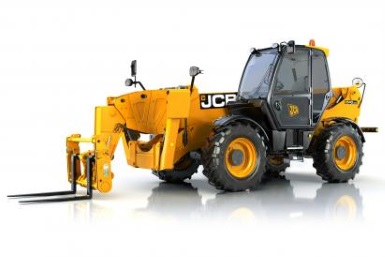Complete Powerpoint slide presentation for forklift instructors. Ready made training course
Complete Telehandler training course
 Most of the general operator safety rules for these machines are the same or similar to those for counterbalanced trucks. There are obvious differences however, the most obvious of which, is that they are designed to run on rougher terrain than counterbalanced trucks. This in turn means that they are inherently designed to be more stable. Having said that, operators should receive training in stability principles and using the counterbalanced section of this website would usually be sufficient. (This opens in a separate window so that you can easily get back to here).
It should be pointed out that whilst telehandlers are more inherently stable than conventional forklift trucks, they are nowhere near as stable as is popularly believed.
Most of the general operator safety rules for these machines are the same or similar to those for counterbalanced trucks. There are obvious differences however, the most obvious of which, is that they are designed to run on rougher terrain than counterbalanced trucks. This in turn means that they are inherently designed to be more stable. Having said that, operators should receive training in stability principles and using the counterbalanced section of this website would usually be sufficient. (This opens in a separate window so that you can easily get back to here).
It should be pointed out that whilst telehandlers are more inherently stable than conventional forklift trucks, they are nowhere near as stable as is popularly believed.
As part of the stability test process telehandlers are placed on a platform, which must be tilted to preset angles to assess stability. Across the slope, and with rated maximum load at full lift height, this angle is only 7°. Most telehandler operators and supervisors, when asked, estimate that it is in the region of 25°- 30°, which is a significant over estimate. *NOTE: The procedure is somewhat more complicated than this in reality
Other differences are travel heights for the forks when laden or unladen and the increase in blind spots on these machines. To avoid repetition I have not listed all of the operator safety code in this section but the ideal would be to use the counterbalanced truck safety code and change any items that are not appropriate to your particular telehandler. The slides following this one can then be used to cover the practical sessions.
The HSE have published a booklet called The safe Use of Telehandlers in Construction which can be downloaded free from here. There is also a section on the HSE website dealing with telehandler safety. The information on the HSE's website should always be taken into account as it represents the law of the land.
Please note that this course covers only basic training of telehandler operators. Basic telehandler operator training does not include the lifting of suspended loads, the lifting of persons or the use of other attachments. If such tasks are to be carried out the employer must ensure that the operator is suitably trained and assessed as competent. In addition basic operator training for non-rotating machines does not cover rotating machines.
Disclaimer. The legislative information contained on this web site is my interpretation of the law based on many years in the health and safety business. A definitive interpretation can only be given by the courts. I will therefore not be held responsible for any accident/incident/prosecution arising as a consequence of anyone using any information obtained from this web site.